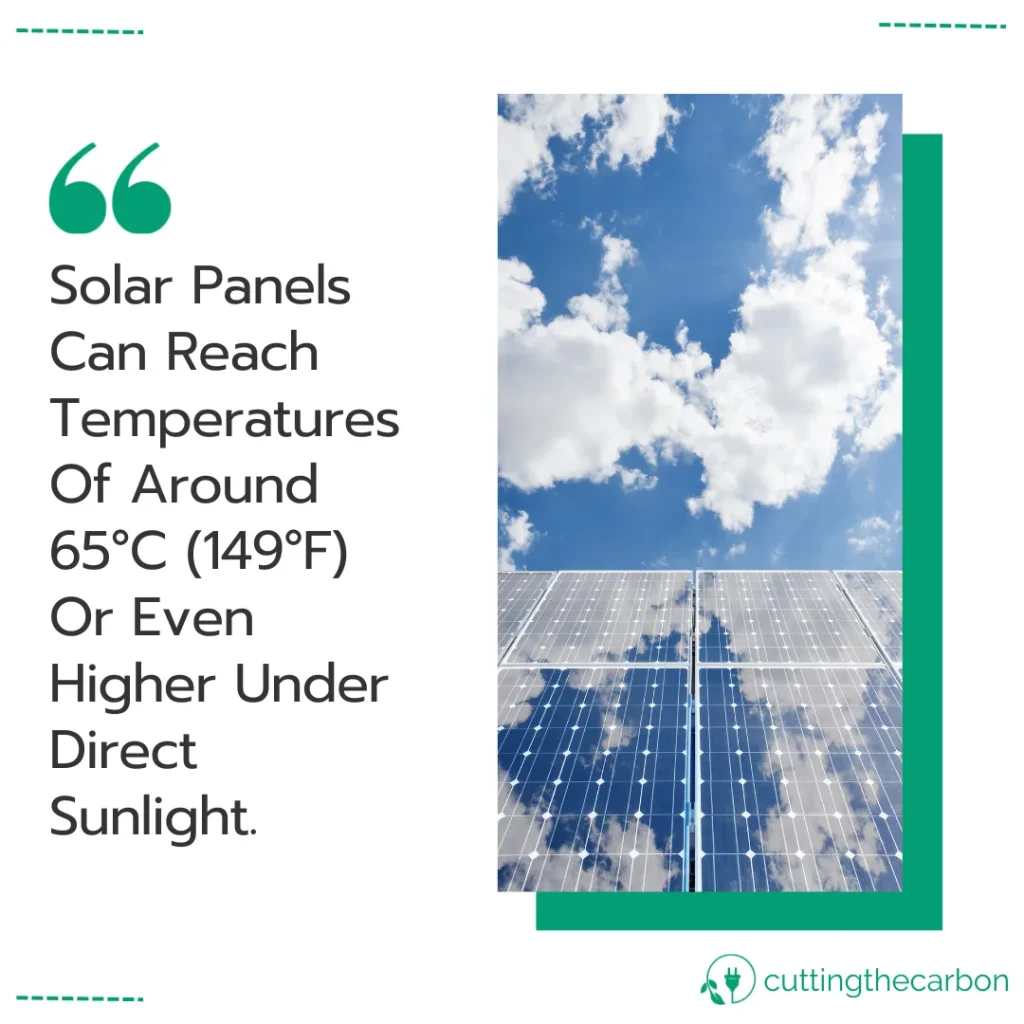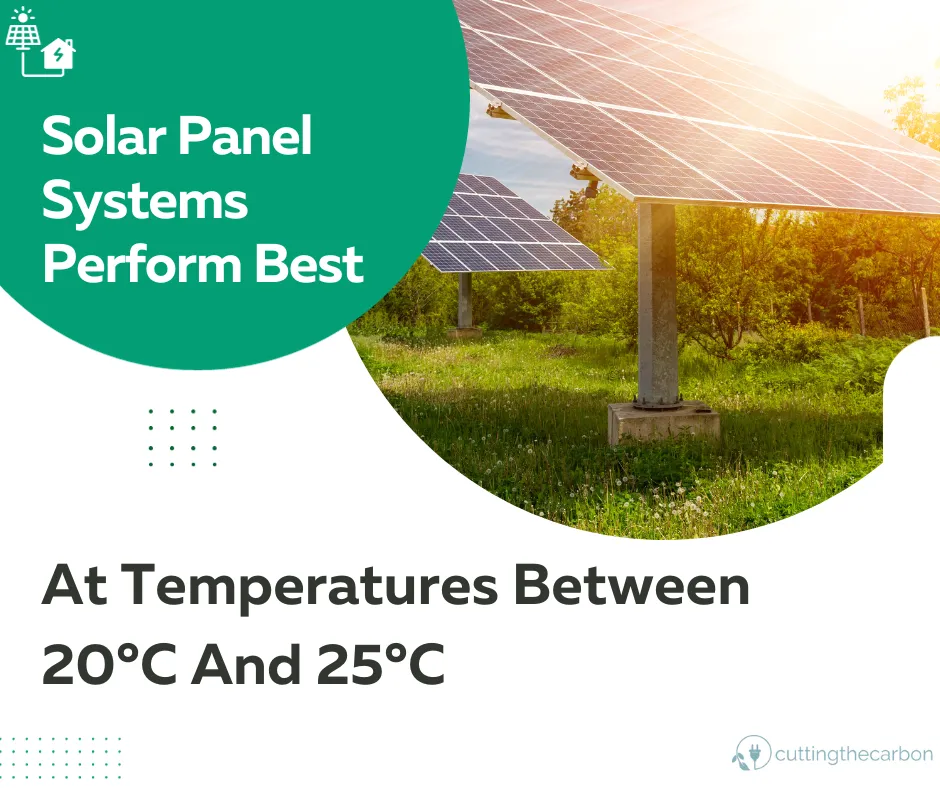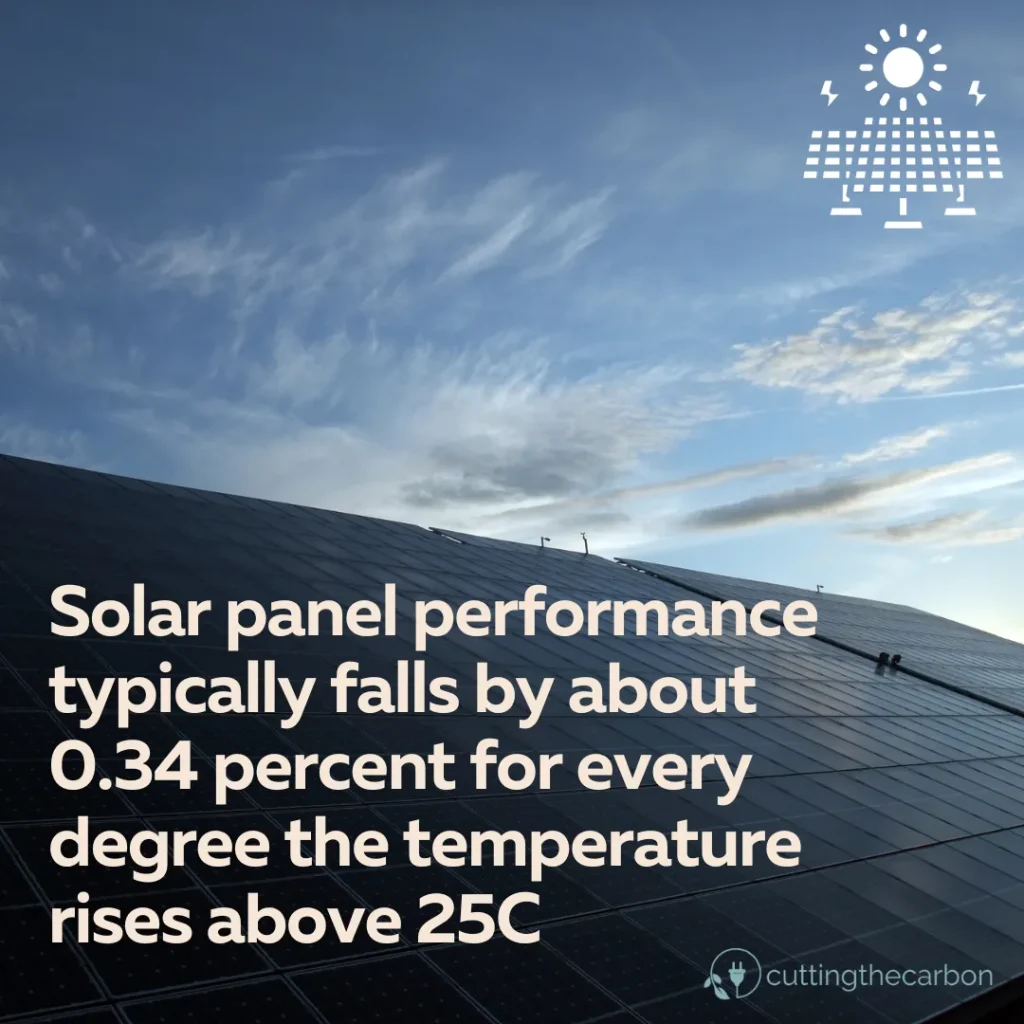How hot do solar panels get? That’s a burning question many homeowners grapple with.
The answer to this query is not as simple as it appears. Solar panel temperatures can fluctuate wildly, impacting their efficiency and your energy savings.
Digging into the heat dynamics of solar panels reveals some surprising facts. For instance, did you know solar panels operate optimally at around 25°C? Anything above this temperature could potentially hamper their performance.
This begs another question: if solar panels are designed to absorb sunlight, how can they avoid getting too hot in the process? Let’s find out.

The Intricacies of Solar Panel Temperatures
Temperature plays a vital role in the operation and efficiency of solar panels. During their regular functioning, these green energy devices can heat up to between 15°C and 35°C.
Under direct sunlight, solar panels may be heated to a scorching 65°C (149°F). This is not just typical heat – it’s potentially damaging to your solar system.
Solar Cells: The Heat Effect
You might wonder why this matters. When the surface temperature rises above optimal levels due to increased exposure to the sun’s rays or higher ambient air temperature during warmer months like summer, it directly affects how well photovoltaic cells within the panel perform.
A study by ScienceDirect provides insight into how semiconductor materials used in PV cells, such as silicon, lose effectiveness at hotter conditions, leading to decreased power generation from your home solar panels despite having plenty of sunshine available.
Balancing Sunlight Exposure & Temperature Rises
In essence, while you want enough light hitting those PV panels to generate electricity efficiently using the sun’s energy, too much actual temperature could cause them harm.
So what does one do?
- Maintain appropriate spacing around installed modules, allowing proper airflow, thus reducing the chances of overheating issues arising from prolonged exposure to sunny days’ intense radiation.
- Avoid installing them near surfaces that reflect excessive amounts of external temperature onto the panel surface, such as a hot parking lot scenario, which can significantly raise the overall thermal load beyond tolerable limits.
- Last, consider investing in newer models designed with thermally conductive substrates, offering better resistance against high temperatures ensuring sustained performance over longer periods without any major drops caused by weather extremes.
Temperature is a crucial factor in solar panel efficiency. While they typically heat up to 15-35°C, extreme sunlight can push this to a damaging 65°C. To maximise output and protect your panels, ensure good airflow around them, avoid hot reflective surfaces nearby and consider models with thermally conductive substrates.
Understanding Temperature Coefficients in Solar Panels
Temperature is a key element in the solar panel realm. The term ‘temperature coefficient’ might sound complex, but it simply indicates how much power output is lost for every degree Celsius rise above 25 °C.
This percentage varies across manufacturers and types of PV cells, which can significantly affect your energy generation on hot days.
Thin Film Panels Vs Traditional Panels
The debate between thin film panels and traditional monocrystalline or polycrystalline panels often comes down to their respective temperature coefficients.
- Traditional panels are known for their high efficiency rates but have higher negative temperature coefficients, resulting in more significant losses as temperatures increase (source).
- In contrast, thin-film technology boasts lower coefficients, meaning less heat-induced loss despite its lower efficiencies per square meter due to the unique layering process during production.
- Sunpower and REC Group produce low-coefficient solar panels that offer better performance under high ambient temperatures than other brands without sacrificing too much space (SunPower Official Site, REC Group Official Site).
What Effect Does Temperature Have On Solar Panels? Video
Facing Future Trends: High-Temperature Resistant Photovoltaic Cells
New trends, such as silicon photovoltaic cells designed with semiconductor materials resistant to increased heat, aim to overcome the limitations associated with the typical thermal properties of current PV systems.
We’re seeing new designs that allow improved airflow, reducing surface temperatures and thereby boosting overall efficiency – truly exciting times ahead.
The Impact of Ambient Temperature on Solar Panel Efficiency
Ambient temperature plays a crucial role in solar panel efficiency. External factors like air temperature and direct sunlight significantly influence your solar panels’ conversion rate of light into usable electricity.
PV cells are most efficient at around 25 degrees Celsius under ideal conditions. But we all know they often face much higher temperatures during sunny days. This is where high ambient temperatures come into play, causing overheating issues with your solar panels, which can lead to decreased energy output.
Hot Parking Lot Scenario
Imagine leaving a car parked in a hot parking lot on an extremely sunny day without any shade or cooling mechanism. The surface temperature quickly rises due to increased heat from the sun’s rays hitting its metal bodywork directly.
This situation is not too different for rooftop-installed solar panels receiving direct sunlight throughout the day for extended periods. Their surface temperature increases dramatically under these circumstances, reducing performance and lower power generation capabilities.
Understanding how to manage external influences such as these becomes critical when aiming for optimal solar panel efficiency.

Maximising Solar Energy Output in Different Climates
Your geographical location significantly affects your solar panels’ performance and energy output. Interestingly, Northern Ireland is an example where less sun radiation doesn’t mean less efficiency.
The region receives approximately 60% of the sun’s radiation compared to equatorial areas but still effectively utilises solar panel technology for generating electricity.
Dealing with High Temperatures
Managing high temperatures in regions experiencing hotter climates becomes crucial to maintaining optimal photovoltaic system efficiency.
While warmer weather increases sunlight exposure – which should be beneficial for power generation – it can also lead to higher surface temperatures on PV cells, negatively affecting solar panel efficiency.
This temperature rise could reduce overall energy output due to decreased silicon photovoltaic cell productivity. However, summer remains essential for producing usable electricity from your home solar panels as longer days offer more hours of direct sunlight hitting your PV system.
Strategies such as installing thermally conductive substrates or ensuring adequate airflow around installed panels are worth considering to mitigate this issue.
These measures help dissipate heat and keep the actual temperature within a manageable range, improving overall energy yield even under hot climate conditions.
How Hot Do Solar Panels Get? A Deep Dive into Efficiency
Uncover how hot solar panels get, understand how temperature influences their efficiency, and learn tips to optimise your home’s solar energy output.
Overcoming Overheating Issues in Solar Panels
The rise of temperature on the surface of solar panels can lead to a decline in energy output. However, there are strategies available that homeowners can utilise to tackle this issue.
A practical method is incorporating thermally conductive substrates during installation. Thermally conductive substrates can facilitate heat dispersal from PV cells, thereby helping them work at an optimal temperature for optimum efficiency.
Besides choosing suitable materials, ensuring adequate airflow space around your home solar panels also plays a pivotal role.
By providing sufficient ventilation beneath installed panels, you allow hot air to escape more readily, which aids in keeping the overall system cooler under direct sunlight conditions.
Tackling Panel Overheating: Practical Tips
If you’re contemplating installing solar panels or already have them at home, it’s crucial to comprehend how increased heat impacts their performance and what measures one could take towards maintaining their efficiency when faced with higher temperature conditions.
An effectively planned setup taking into account local climate factors coupled with regular maintenance checks will contribute significantly towards optimising your system’s productivity throughout its lifespan.
Finding Tailored Solutions For Your Home With EnergySage Solar Marketplace
To further assist homeowners seeking solutions tailored specifically to their needs, platforms like EnergySage Solar Marketplace offer invaluable resources where they can gather information about different types of PV systems along with quotes from pre-screened installers located nearby.

Investing Wisely – Choosing The Right Solar PV System For Your Home
Picking the right solar PV system is not just about saving money on energy bills. It’s also about maximising your home’s potential to generate electricity from sunlight.
The choice of a suitable panel largely depends on local weather conditions and how much direct sunlight hits your roof. These factors directly influence the efficiency of solar cells, thus affecting overall power generation.
SunPower, Panasonic, and REC Group are known for their high-quality panels with low-temperature coefficients – ideal options if you live in warmer climates where higher temperatures can decrease solar panel efficiency.
| Topic | Details |
|---|---|
| Optimal Solar Panel Temperature | Solar panels work at maximum efficiency when their temperature is as cool as possible. They are tested under the condition of 25°C (or 77°F) with 1,000 watts of light per square meter. Most solar panels have a rated max temperature of 185°F. |
| Are Solar Panels Hot to Touch? | Solar panels are generally 36°F warmer than the ambient external air temperature. For instance, if the ambient temperature is 113°F, solar panels can reach 149°F. |
| Temperature Coefficient | It’s the percentage decrease in energy production for each increase in degree Celsius over 25°C (or 77°F). A low temperature coefficient is best. For example: SunPower’s X21-350-BLK has a coefficient of -0.29%/°C. |
| Solar Panel Efficiency | Efficiency is the percentage of light that strikes the surface of the photovoltaic cell that is then converted into energy. Most reputable solar brands have an efficiency between 15% and 20%. |
| Premium-brand Panel Worth | Premium panels lose less output as temperature rises, have higher efficiency, and come with better warranties. Tier 1 brands, such as Sunpower and Panasonic, are considered the highest quality. |
| Solar Panel Warranty | There are product warranties and power output warranties. Product warranties typically last for 10 years, while power output warranties guarantee a certain percentage of rated output, usually for 25 years. For example, SunPower offers 25 years product warranty with 98% output after Year 1. |
| Choosing Based on Temperature Coefficient | The temperature coefficient should not be the primary concern. High-quality panels from Tier 1 brands are recommended for optimal performance and efficiency. |
Navigating Through Different Panel Types And Their Temperature Coefficients
Solar panels come in various types: monocrystalline, polycrystalline, or thin-film, each offering unique characteristics under different temperatures. Realising the contrasts between them can assist with guaranteeing you’re settling on a shrewd choice when selecting a photovoltaic cell type for your home.
Monocrystalline Panels:
If cost isn’t an issue, consider monocrystalline panels, which have better heat tolerance than other types but at a premium price point. Their superior performance, even during hot days, makes them worth considering despite being pricier than others. Weighing Polycrystalline Options:
Polycrystalline variants offer good value for money but may falter slightly under hotter conditions due to their higher temperature coefficient, which could affect solar panel efficiency. Despite this drawback, they still make an excellent choice, especially if budget constraints exist while planning your green technology investment strategy.
Thin-Film Technology:
Last up is thin-film technology; it stands out thanks to its low-temperature coefficient. Thin-film technology solar panels are lightweight and flexible, allowing for versatile installation options and integration into various surfaces.
Additionally, they often have a lower manufacturing cost and can perform better in low-light conditions than traditional crystalline silicon panels.
Polycrystalline solar panels
Polycrystalline solar panels are known for their blueish hue and are typically more cost-effective to produce than their monocrystalline counterparts.
They also have a slightly lower heat tolerance, which can result in slightly reduced efficiency in high-temperature environments but offer a good balance of efficiency and affordability for many solar applications.
Future Trends in Solar Panel Manufacturing
The horizon of solar panel manufacturing is glistening with promising innovations. One such development that’s making waves involves silicon photovoltaic cells designed with semiconductor materials that are more resistant to high temperatures.
Semiconductor substances like gallium arsenide and perovskite have been showing their mettle in lab tests for their ability to endure higher temperatures without a significant drop in efficiency. The boffins at institutions, including Cambridge University, are working around the clock to bring these technologies into commercial viability.
Newly emerging designs of panels that allow better airflow thus reducing surface temperature, are also being brought onto the drawing board. These innovations boost efficiency by maintaining optimal operating conditions even under scorching sunlight and hot climates.
Airflow Enhanced Designs: A Game Changer?
Certain trailblazing companies have already introduced patented technology that enhances airflow between individual solar cells within a panel; this smart move reduces heat build-up while enhancing performance substantially – an example worth noting.
This trend indicates an exciting shift towards improved energy output from our sun, irrespective of external temperature fluctuations or geographical location constraints.
It’s clear that in the future, manufacturers will continue evolving products based on cost-effectiveness and considering factors affecting solar panel efficiency, such as ambient temperature and direct exposure to sunlight.
FAQs About How Hot Do Solar Panels Get
How hot do solar panels get?
Solar panels typically operate between 15°C and 35°C, but under intense sunlight, their surface temperature can soar up to around 65°C.
How much heat do solar panels give off?
Solar panels convert sunlight into electricity rather than heat. However, they can absorb excess heat from the sun, which may slightly warm surrounding areas.
How Hot Can Solar Panels Get: Final Thoughts
Understanding solar panel temperatures is a complex yet fascinating journey.
The efficiency of these green energy powerhouses hinges on their operating heat levels.
Solar panels can hit as much as 65°C, but their operation is most effective between 15 and 35°C.
Ambient temperature plays a significant role in this dynamic, as does the type of solar panel used.
With clever strategies like proper airflow space during installation or choosing panels with low temperature coefficients, we can optimise our home’s solar output even in warmer climates.
At Cuttingthecarbon, we offer tailored solutions to help you optimise your solar output and reduce your carbon footprint while saving money on energy bills – let’s make the most of those sunny days together!

